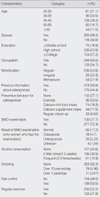Abstract
Methods
The process included construction of a conceptual framework, generation of 86 preliminary items, verification of content validity, selection of secondary items, verification of construct validity and extraction of final items. The 86 items were reviewed for content validity by two groups of experts and were tested to evaluate inter item correlation coefficient by two groups of adult women. From June to August 2007, data were collected from 383 adult women who lived in Seoul and provinces in Korea. Data were analyzed by performing item analysis, Varimax factor analysis and Cronbach's alpha.
Results
There were 31 items in the final instrument categorized into 5 factors. The factors were labeled as "preventive behaviors (10 items)", "risk factors (5 items)", "characteristics of osteoporosis (6 items)", "improving bone health (5 items)", and "bone physiology (5 items)". Cumulative percent of variance was 60.92% and eigen values ranged from 1.20 to 12.44. Cronbach's alpha was .948 and ranged from .804 to .917.
Figures and Tables
References
1. Ailinger RL, Harper DC, Lasus HA. Bone up on osteoporosis: Development of the Facts on Osteoporosis Quiz. Orthopedic Nursing. 1998. 17(5):66–73.
2. Ali NS, Bennett SJ. Postmenopausal women. Factors in osteoporosis preventive behaviors. Journal of Gerontological Nursing. 1992. 18(12):23–32.
3. Barbara HM. Statistical methods for health care research. 2001. 4th ed. Philadelphia, NY: Lippincott-Williams and Wilkins.
4. Berarducci A, Lengacher CA, Keller R. The impact of osteoporosis continuing education on nurses' knowledge and attitudes. The Journal of Continutin Education in Nursing. 2002. 33:210–216.
5. Black JM, Hacks JM, Keene AM. Adult health nursing. 2007. Seoul: Jung Dam Media Publishing.
6. Ferketich S. Focus on psychometrics. Aspects of item analysis. Research in Nursing & Health. 1991. 14:165–168.
7. Gambert SR, Schltez BM, Hamdy RC. Osteoporosis. Clinical features, prevention and treatment. Endocrinology and Metabolism Clinics of North America. 1995. 24:317–371.
8. Grady IJ. Factors influencing stage of change and osteoporosis prevention behaviors. 2000. PA, USA: University of Pittsburgh;Unpublished doctoral dissertation.
9. Kim BS. Menopause women and exercise. Korean Journal of Health Promotion and Disease Prevention. 2001. 1:1–7.
10. Kim K, Horan M, Gendler P. Osteoporosis knowledge tests, osteoporosis health belief scale and osteoporosis self-efficacy sale. 1991. Allendale, MI: Grand Valley State University Press.
11. Kim MH, Kim MS. A study on the relationships between knowledge about osteoporosis and cognitive factors in middle-aged women. Korean Journal of Women Health Nursing. 2005. 11:52–57.
12. Korea Statistical Information Service data. Health Social Welfare Statistics. 2002. December. Retrieved May 30, 2007. from
http://www.kosis.kr./domestic/theme/2001_index.jsp htm# National.
13. Lee HS, Kim Y. Hangul SPSS 10.0 guide for beginner. 2002. Seoul: Bomunsa Publishing.
14. Lynn MR. Determination and quantification of content validity. Nuring Research. 1986. 35:382–385.
15. Ministry of Health and Welfare. Identification of characteristics and pathogenesis of osteoporosis in Korea and search for new drugs. 2005. Seoul: Author;Report of Health Medicine Technical Infra Development Project.
16. National Osteoporosis Foundation data. Fast facts on osteoporosis. 2008. Retrieved March 30, 2008. from
http://www.nof.org/osteoporosis/diseasefacts. htm# National.
17. Pande KC, de Takats D, Kanis JA, Edwards V, Slade P, McCloskey EV. Development of a questionnaire (OPQ) to assess patient's knowledge about osteoporosis. Maturitas. 2000. 37:75–81.
18. Sedlak CA, Doheny MO, Jones SL. Osteoporosis Education Programs: Changing knowledge and behavior. Public Health Nursing. 2000. 17:398–402.
19. Shin KR, Kang YM. A study on the relationships between osteoporosis knowledge, self-efficacy and health belief of woman in an island. Journal of Korean Academy of Nursing. 2002. 32:89–99.
20. Sin SJ, Shin KR, Yi HR, Ju SK. Knowledge, health belief, and self-efficacy related osteoporosis. Journal of Korean Academy of Nursing. 2005. 35:850–857.
21. Song HR. Effects of the knowledge, health belief, and self-efficacy of osteoporosis on calcium intake behavior for postmenopausal osteoporosis patients. 2007. Daejeon: Cheonnam National University;Unpublished master's thesis.
22. Sun KS. The effect of web-based osteoporosis prevention program on the osteoporosis knowledge, self efficacy, health belief, stage of change in female college students. 2003. Gwangju: Cheonnam National University;Unpublished doctoral dissertation.
23. Werner P. Knowledge about osteoporosis: Assessment, correlations and outcomes. Osteoporosis International. 2005. 16:115–127.
24. Winzenberg TM, Oldenburg B, Frendin S, Jones G. The design of a valid and reliable questionnaire to measure osteoporosis knowledge in women: The Osteoporosis Knowledge Assessment Tool (OKAT). BMC Musculoskeletal Disorders. 2003. 24:4–17.
25. World Health Organization. WHO study group on assessment of fracture risk and its application to screening for postmenopausal osteoporosis. Assessment of fracture risk and its application to screening for postmenopausal osteoporosis. 1994. Geneva, Switzerland: Author;Technical Report No. 843.
26. Yang SA. A study on the relationships between osteoporosis knowledge, self-efficacy and health belief of women in urban city. Korean Women's Health. 2005. 6:19–44.




 PDF
PDF ePub
ePub Citation
Citation Print
Print





 XML Download
XML Download